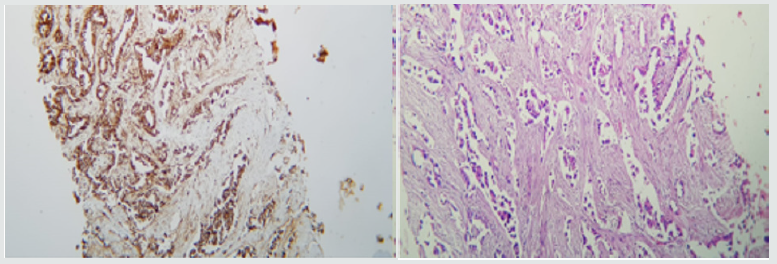Lupine Publishers | Journal of Otolaryngology Impact Factor
Abstract
Keywords: Pneumothorax; Pulmonary Cavitation; Pulmonary Adenocarcinoma; Ovarian Metastasis; TTF1
Introduction
Case Report
Figure 1: (a) Chest X ray; (b) Axial computed tomography with extensive pulmonary parenchymatous involvement.
(c) Computed tomography of the abdomen and pelvis with mass surrounding uterus.


Figure 2: (b) Immunohistochemistry of Napsine A in lung tissue;
(b) Immunohistochemistry of TTF1 in ovarian tissue.

a greater extent induced by oncologic management are infection
and hemoptysis, very infrequently, the presence of spontaneous
pneumothorax which is estimated between 0.03 and 0.05% of
primary lung cancer with a poor prognosis [3,4]. Among 1200
patients with spontaneous pneumothorax between 1970 and
2007, 37 (3%) had lung cancer. In all patients, the pneumothorax
occurred on the same side of the carcinoma. The main cause of
spontaneous pneumothorax was rupture of a necrotic tumor
nodule or necrosis of subpleural metastases (21 ptes)., As well as
the communication between the bronchus and the pleural cavity,
producing a bronchopleural fistula that results in pneumothorax
[5]. Spontaneous pneumothorax in the context of lung cancer
occurs in 75% of cases as an initial manifestation and the remaining
25% during the course of the disease in patients with the known
diagnosis, sometimes after the onset of management [6]. In this
case, the first clinical manifestation of oncological disease was the
presence of dyspnea secondary to spontaneous pneumothorax,
infectious causes were ruled out and required surgical intervention
with subsequent need for high oxygen flow. The main sites of
lung cancer metastasis are pleura, brain, bone and liver. Ovarian
metastases are rare, accounting for 5% of all ovarian cancers.
The main tumors that metastasize to the ovary are from the
gastrointestinal tract: colon and gastric, or originated in the breast.
Lung cancer alone is the cause of these metastases by 0.3% [7].
The metastases of an adenocarcinoma of the lung are difficult to
distinguish from a primary carcinoma of the ovary. Although there is
no specific lung marker, TTF-1 can be used to discriminate between
primary pulmonary and ovarian. TTF-1 is positive in approximately
63% of lung cancers [8]. Irving and Young reported 32 cases of
metastatic to ovarian lung carcinoma in women aged 26 to 76. A
history of lung carcinoma was documented in 53% of cases (17 out
of 32), with detection of ovarian involvement at an interval of one
year. In 10 cases (31%) ovary and lung occurred synchronously, in 5
(16%) ovarian tumors were detected 26 months before lung injury.
The most frequent histologic subtype was small cell carcinoma
44%, adenocarcinoma in 34% and 16% in large cell carcinoma
in 16% of patients. One third had bilateral presentation and the
most frequent morphological characteristics were: multinodular
growth, necrosis, lymphovascular invasion with rare involvement
of the ovarian surface [9]. The management decision in this
case was made considering the presence of pulmonary visceral
crisis, the patient’s age, her ECOG and the high risk of rapidly
deteriorating. Chemotherapy with palliative intention was started
with carboplatin paclitaxel with a good clinical response in the two
initial cycles, with which the requirement of supplementary oxygen
and control of dyspnea was reduced. 40 days later, the patient was
admitted with subite dyspnea of 3 days of evolution. with chest
x-ray (Figure 3) that evidences left pneumothorax, ventilatory
failure and dies despite rescue procedure.
Conclusion
For more Lupine Publishers Open Access Journals Please visit our website: h
http://lupinepublishers.us/
For more Journal of Otolaryngology-ENT Research articles Please Click Here: https://lupinepublishers.com/otolaryngology-journal/
To Know More About Open Access Publishers Please Click on Lupine Publishers
Follow on Linkedin : https://www.linkedin.com/company/lupinepublishers
Follow on Twitter : https://twitter.com/lupine_online


No comments:
Post a Comment